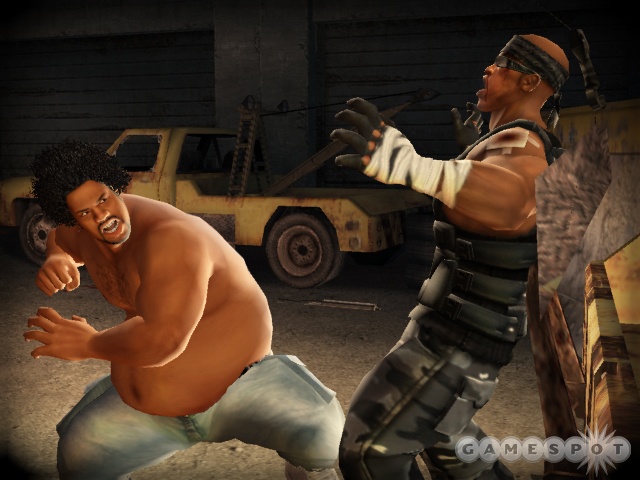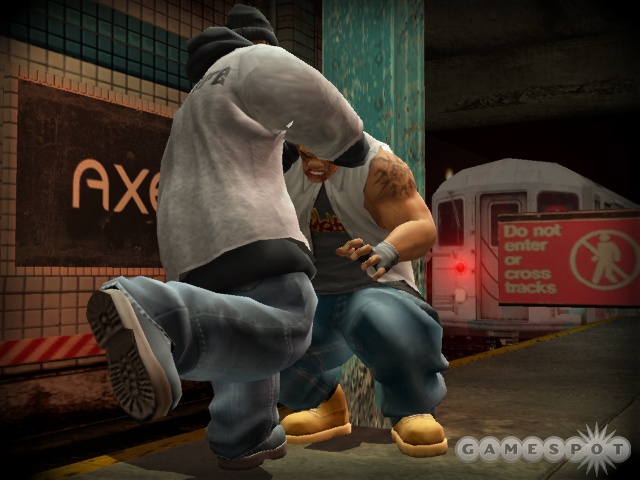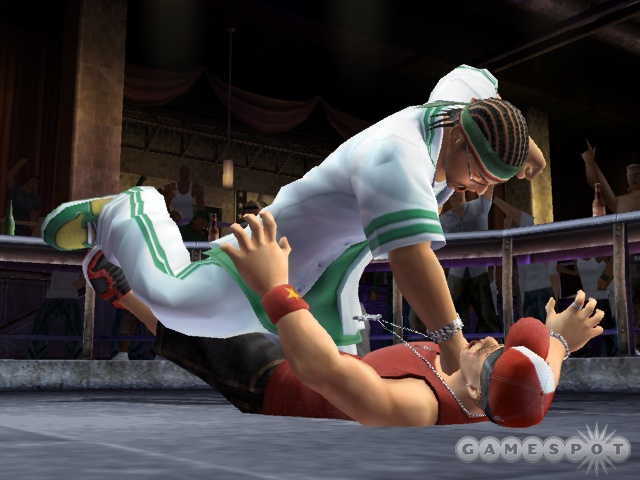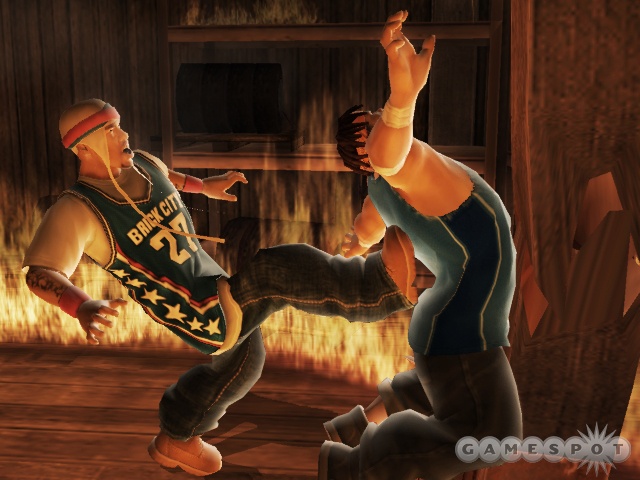Def Jam: Fight for NY Designer Diary #1
Producer Josh Holmes fills us in on the process of formulating the newest Def Jam wrestler.
After the success of Def Jam Vendetta, the folks at EA Canada and Aki could have rested on their laurels, cranking out a cookie-cutter sequel to the hip-hop-themed wrestler and raking in the subsequent cash flow. Fortunately for us, the development teams have gone far beyond that, crafting an original and extremely promising new game in the series for fans to chew on. Producer Josh Holmes is here to tell us about the process of creating the newest Def Jam game from the ground up.
Flipping the Script: Redefining the Fighting Game
By Josh HolmesProducer, EA Canada

What makes a great fighting experience? Is there anyone out there who isn't completely bored with the traditional fighting game?
These were two of the questions we asked ourselves when we started on Def Jam: Fight for NY.
Conventional fighting games have been pyramid-like in the way that they have developed over the years. The higher they have evolved from their early foundations, the narrower their focus and appeal has become. Each new version seeks to improve upon previous iterations by adding more complexity to the control system. The focus has been on the multiplayer experience to the exclusion of all else. The result has been a very shallow single-player experience, limited character customization, and gameplay that is totally skewed toward the hardcore gamer.
With Def Jam: Fight for NY, we wanted to do things differently. We wanted to create a fighting system that was simple and rewarding enough at its core that any new player could pick up the controls and do some cool stuff. At the same time, we knew we needed great variety, underlying depth, and strategic play to keep things interesting for more advanced players. We sought to create something new and original that took cues from fighting games, wrestling games, and classic beat-'em-ups. We also wanted to disprove the notion that a fighting game can't have a deep single-player experience and storyline.
The first thing we did with the gameplay was set out to identify all the most exciting things that could possibly happen in a fight. We did a ton of research by watching fight sequences in movies and footage from hardcore fighting competitions. This helped us to create a huge list of ideas. Whether it was breaking a pool cue over an opponent's head, raking his face across a chain-link fence, running up his chest to deliver a kick to his chin, or smashing him through a car window, we wanted to make it possible in the game.
Next we focused on developing a control system that allowed users to pull off these attacks easily and naturally within the flow of a fight. We came up with a simple palette of mechanics that allowed users to perform a huge assortment of attacks, depending on the objects and situations presented within each environment. From there we went about creating and populating the many environments available in the game. One of our primary goals was to keep the gameplay experience constantly changing while introducing a variety of strategic elements into the fight.

So in the subway station, not only can fighters beat their opponent silly with their fists or slam a character headfirst into the pillars, pop machine, and newspaper box, they can get really serious and toss them in front of the moving train.With the new emphasis on creating strategic gameplay opportunities, we managed to set up a lot of hidden weapons and interactions. An expert player is going to have the upper hand when it comes to knowing where to find all these painful goodies in a given environment. If you get slammed into the dumpster at Hunt's Point Scrap Yard, your opponent can knock a welding torch loose. At Club Babylon, a character can grab one of the fluorescent lighting tubes off the wall and smash it over someone's head. In Gun Hill Garage, fighters can loosen the muffler on an SUV and then use it to beat some sense into their opponent.
Another thing that became really obvious early on in preproduction is that it's fun to break stuff.
Busting S*** Up
Seriously, what is more satisfying than having a fighter busting up a jukebox using his opponent's face, or kicking someone through the wooden support beams that are holding up the roof? Players want to see the path of destruction left behind them as they lay waste to their opponents. This was something we concentrated on with the moves in our fighting system, and it factored into the design of our environments.
When you finish a fight in our world, you know that some serious s*** has gone down. The floor is stained with blood and littered with broken glass and bits of debris. There are spent weapons scattered around the fight area and all of the walls and surrounding objects are smashed and shattered. Bodies are flying and things are being broken.

One fundamental principle of our fights: they don't take place in a vacuum.
I'm sick of playing fighting games where you and your opponent are going toe-to-toe at the top of a mountain or in an open field. What do all the locations in your typical fighting game have in common? They're empty and devoid of other people. There's absolutely nothing going on except the toe-to-toe action between you and your opponent.
Enough already.
If you see a fight in the real world--whether it's an arranged bout or a spontaneous disagreement--people will be there. Likewise, when you throw down in FFNY there is usually a crowd present, and unless there's a barrier separating them from you, they are an active element of the fight. You can push your opponent into the crowd and they will throw him back or put the hurt on him themselves. We created a simple yet robust system of crowd interaction whereby you can knock your opponent into the onlookers and then create team-up moves where the crowd helps players knock some sense into their opponent.
One thing is a constant in every venue: the crowd wants action. In fact, they'll go out of their way to encourage the fight. These people came to see a beat-down, and they don't want to leave disappointed. As the fight progresses, they'll doll out weapons that characters can use to really drive home a point. Nothing says "I don't like you" like breaking a bat across your opponent's face.
On the story side, we've pushed really hard to create a fiction that will compel you to keep fighting. You create your character and step into the world of Def Jam. From there it's up to you to choose your path through the fight clubs. Along the way, you'll be caught up in an epic storyline of trust and betrayal as D-Mob and Crow fight for control of New York's underworld.

Def Jam: Fight for NY is an awesome single-player experience, especially with all of the character customization you can do for your created fighter. But when you're playing against friends, things get even crazier. Grab three of your buddies and head into battle mode for some serious ass-kicking fun. You've got a ton of match types and environments to choose from, and we've designed the movement and attack system to maximize the multiplayer mayhem. You can either team up or go every man for himself. Just make sure you watch your back so you don't get triple-teamed--trust me, I speak from experience here.
Looking back, we had a clear vision of the game we wanted Def Jam: Fight for NY to become. Our goal was nothing less than the redefinition of the fighting game. Now that we're finally nearing completion, I think it's safe to say: mission accomplished.
Got a news tip or want to contact us directly? Email news@gamespot.com
Join the conversation